Day 1:
Arrival in Lima . We will arrive in Lima in the early evening and make our transfer to a hotel nearby.
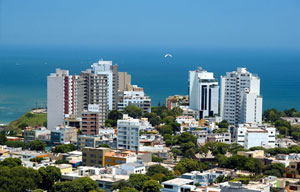
Arrival in Lima . We will arrive in Lima in the early evening and make our transfer to a hotel nearby.

After a good night’s sleep and a relatively late start we drive south of Lima towards Pucusana. Our first stop will be a small nature reserve on the outskirts of Lima, Villa Marshes. Here we will see Andean Coot, Puna Ibis, Great and White-tufted Grebes, Cinnamon Teal, White-cheeked Pintail, Franklin’s Gull, Gray-hhooded Gull, Bay-winged and Red-backed Hawk. We will make selected stops along the way in agricultural areas particularly for Peruvian Thicknee, Yellowish Pipit, Short-tailed Field Tyrant and others. Other possibilities include a variety of Seedeaters including Drab (endemic), Parrot-billed and Chestnut-throated as well as Scrub Blackbird and long-tailed Mockingbird. After a seafood lunch a boat trip around Pucusana Bay will produce nesting Guaynay and and Peruvian Boobies is a stunning sight, not to mention the colonies of South-American Sea-lions. . Our targets here are the lovely Inca Tern, Blackish Oystercatcher, Peruvian Pelican, Red-legged Cormorant, Gray Gull, Peruvian Seaside Cinclodes and Humboldt Penguin. A stop in roadside scrub should produce Oasis and Amazillia Hunmingbirds and Peruvian Sheartail. A last stop at San Pedro and Lurin will give us a chance at many shorebirds, Peruvian Tern, Chestnut-collared Swallow, Pacific Bran-colored Flyctacher We return to our hotel in Lima for the night. (B,L,D)
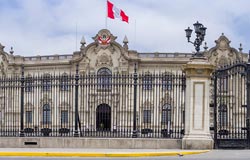
Today we will visit the Lomas de Lachay, an area of low coastal hills that are covered in a unique ‘fog vegetation’ (i.e. the sparse plant life obtains its moisture almost entirely from condensation in this almost rainless landscape). Bare desert en route to the Lomas is home to the endemic Coastal Miner, whereas higher up in the hills we may find Greyish Miner and the endemic Thick-billed Miner. At times Least Seedsnipe, Tawny-throated Dotterel and Yellowish Pipit nest in this area, while other birds we may find on the green slopes of the Lomas are Black-chested Buzzard-Eagle, Variable Hawk, American Kestrel, Eared Dove, Croaking Ground-Dove, Oasis and Amazilia Hummingbirds, Vermilion Flycatcher, Blue-and-white Swallow, Hooded Siskin, Grassland Yellow-Finch, Rufous-collared Sparrow and Peruvian Meadowlark. If we are fortunate we will even find the rare and nomadic Raimondi’s Yellow-Finch in this area. A short distance away is a desolate desert canyon, where among the sparse cacti and large boulders we shall look for the endemic Cactus Canastero, and in more open areas we shall keep an eye out for the small desert race nanodes of the Burrowing Owl. On the return journey we shall diligently search recently plowed fields for the cryptic Peruvian Thick-knee and the diminutive Short-tailed Field-Tyrant, while in hedges and brushy areas we may find Groove-billed Ani, as well as Parrot-billed and Chestnut-throated Seedeaters. A brief visit to the Pacific Ocean shore will enable us to watch the numerous seabirds that feed in the nutritious waters of the cold Humboldt current, including the huge Peruvian Pelican, Peruvian Booby, Guanay Cormorant and Band-tailed, Grey and Kelp Gulls. We’ll carry on to our Hotel in Santa Eulalia. (B,L,D)
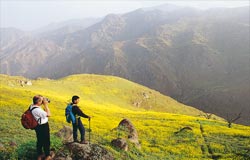
An early start along the dusty but spectacular Santa Eulalia road will take us high into the mountains above Lima. After crossing a bridge over a tremendous chasm we shall reach a shrubby hillside and small ravine where the rare and endemic Rufous-breasted Warbling-Finch is regularly seen. As the early morning sun hits the slopes we will be sorting through flocks of the much more numerous Mourning Sierra-Finches in the hopes of finding this elusive speciality. Lower down we will enter a mosaic of small farms with irrigated fields and hedgerows, where we will check flowering bushes for the endemic Bronze-tailed Comet. Other endemics we will try to find here are Black-necked Woodpecker, Striated Earthcreeper, Rusty-crowned Tit-Spinetail, Canyon Canastero and Rusty-bellied Brush-Finch. Tall groves of introduced Eucalyptus trees often hold the diminutive Peruvian Pygmy-Owl, and depending on weather conditions the majestic Andean Condor may take to the air. Descending farther, we reach the arid cactus-clad slopes, which are the home to another highly prized endemic, the Great Inca-Finch. Other birds we will look for in the course of the day are Bare-faced Ground-Dove, White-tipped Dove, Andean Swift, Sparkling Violetear, Peruvian Sheartail, Purple-collared Woodstar, Pied-crested Tit-Tyrant, White-browed Chat-Tyrant, House Wren, Long-tailed Mockingbird, White-capped Dipper, Chiguanco Thrush, Cinereous Conebill, Blue-capped Tanager, Mourning Sierra-Finch, Band-tailed Seedeater, Golden-bellied Saltator and Scrub Blackbird. We return to our hotel in Santa Eulalia. (B,L,D)
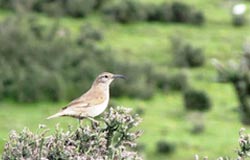
We’ll leave Santa Eulalia early to-day. The cold high-elevation bogs of Marcapomacocha are home to one of the world’s most highly sought-after shorebirds, the exquisite Diademed Sandpiper-Plover. We shall gasp for air as we will be birding at an elevation of over 4500 meters, but the superb set of special birds to be found here will make our physical efforts well worth their while. The scenery is without comparison, and at this time of year we can expect sun and a scattering of snow. Another odd wader we will look for is the large Rufous-bellied Seedsnipe, which often feeds amongst the peaceful llama and alpaca herds at our favorite birding bog. However this partridge-like bird can, in spite of its size, blend in amazingly well with its inhospitable environment. We may well flush a startled Puna Snipe as we search through this often waterlogged habitat, hoping to find four high-altitude endemics: among boulder-strewn grassy areas we will look for the huge White-bellied Cinclodes (one of the most spectacular furnariids), flat areas hold Dark-winged Miner, the sparse flowers attract shimmering Black-breasted Hillstars, whilst in thick bunchgrass we will look for the strikingly-patterned Junin Canastero. Olivaceous Thornbills often walk on matted grass in search for their scarce insect prey, and other birds we may find in this scenic area include Andean Goose, Crested Duck, Mountain Caracara, Grey-breasted Seedsnipe, Andean Lapwing, Andean Flicker, Slender-billed Miner, Plain-breasted Earthcreeper, Bar-winged Cinclodes, Streak-throated Canastero, Puna, Plain-capped, Cinereous, White-fronted and Ochre-naped Ground-Tyrants, Andean Swallow, Correndera Pipit, Plumbeous Sierra-Finch, White-winged Diuca-Finch and Bright-rumped Yellow-Finch. After this fantastic days birding amidst wonderful scenery, we’ll carry on to our superb country hotel in Concepcion for a 3 night stay. (B,L,D)
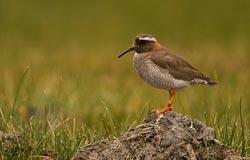
Today we will travel the road to Parihuanca, where the recently discovered and described Black-goggled Brush-Finch occurs. We will pass through a fair amount of high-elevation country, in which we will look for any of the birds missed at Marcapomacocha. Remanant cloud forest patches hold an as yet undescribed race of Wren related to Plain-tailed, and a potentially new species of Tapaculo. The valleys will give us a good cross-section of the more common Andean species, such as Pearled Treerunner, and cloud forest Tanagers. Junin Canstero and Strip-headed Antpitta are here too as well as the endemic Large-footed Tapaculo. We will return to Concepcion for the night. (B,L,D)
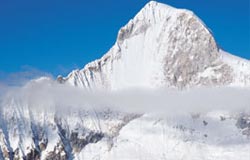
The Satipo road has recently been put on the birding map thanks to the discovery of some desirable species there. Creamy-crested Spinetail will be one of the first birds we’ll try for, before descending into the cloud forests where we hope to find what appears to be an as yet un-described species of Scytolopus Tapaculo. More regular fare should include Shining Sunbeam, Giant Hummingbird, Tyrian Metaltail, Red-crested Cotinga, Torrent Tyrannulet, Blue-and-yellow Tanager, Scarlet-bellied Mountain-Tanager, and Rusty and Black-throated Flowerpiercers. However the elfin-forest habitat is why we are here and we will target Eye-ringed Thistletail and the beautifull Fire-throated Hummingbird as well as our first chance of Tschudi’s Tapaculo. Also in this area are an undescribed species of white-capped Cranioleuca Spinetail and an undescribed Thornbird. We will spend one night in camp here before returning to our comfortable hotel in Concepcion for the night on the last afternoon. (B,L,D)
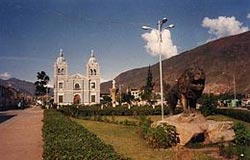
Today we will take to the water in small boats on one of Peru’s largest lakes. Lago Junin is the home of the endemic Puna Grebe (also known as Junin Grebe). This bird is critically endangered and we will have to reach an area of floating reeds to have any chance of observing this species. There will be plenty of other Andean waterfowl such as Speckled and Puna Teal, Yellow-billed Pintail and Andean Duck. Puna Ibises and Andean Gulls are often present in large numbers and with luck we’ll see Andean Avocet as well. The reedy margins hold Wren-like Rushbird and Many-coloured Rush-Tyrant and we have a good chance of seeing them as well as Puna Plover and Plumbeous Rail. We will also do some birding on “terra-firme” in the fields surrounding the lake. Common Miner, Black-billed Shrike-Tyrant, Andean Negrito, Short-billed Pipit and Ash-breasted Sierra-Finch are all possible here. In the afternoon we will make our way to Huanuco. (B,L,D)
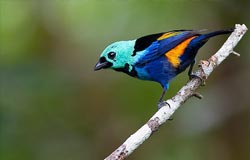
Two full days to explore the forests near the Carpish Pass. We will walk the famous Paty Trail. After a few days in arid habitats birding the cloud- forest here will make a pleasant change. We shall encounter some mixed feeding flocks here and the diversity of birds in these humid habitats will be evident. Yellow-whiskered and Grey-hooded Bush-Tanagers, Black-capped, Oleaginous, Black-eared and Drab Hemispingus and Beryl-spangled Tanagers, Hooded, Lacrimose and Blue-winged Mountain-Tanagers could be seen. We will be alert for another attractive flock member here as well, but the Yellow-scarfed Tanager often passes unoticed lower down as the rest of the birds utilise the higher strata of the trees. More challenging birding is required here and at other elevations to see Trilling, Large-footed and Peruvian Rufous-vented Tapaculos and Rusty-breasted Antpitta. During these periods when we diligently stalk some of these shy creatures there will undoubtedly be passing flocks that may divert our attention momentarily. Furnariids like Streaked Tuftedcheeks and Pearled Treerunners will appear in between the bromeliad festooned limbs of the moss-covered trees, Green-and-black and Band-tailed Fruiteaters give away their prescence with the high pitched calls and with luck we’ll encounter the endemic Masked Fruiteater here as well. Peruvian Tyrannulet is just one of the other endemics to be found here as well as Unstreaked Tit-Tyrant, Inca Flycatcher and Peruvian Wrens. Another species we will be particularly keen to find is the Masked Saltator. More widespread species typical of these subtropical forests in Central Peru that we may see include White-rumped Hawk, Powerful Woodpecker, Rufous Spinetail, Striped Treehunter, Uniform and Variable Antshrikes, Long-tailed Antbird (where bamboo is prevalent), Undulated Antpitta, White-tailed and Mottle-cheeked Tyrannulets, Streak-throated and Smoky Bush-Tyrants. A group of birds that is a great favourite of all birders - trogons - is well represented here with Golden-headed Quetzal and Masked Trogon and the irresistible Grey-breasted Mountain-Toucan will add yet more colour to an impressive cast of Neo-tropical gaudy bird species! We may be brought back down to earth with some of the Basileuterus warblers such as Citrine and Russet-crowned Warblers, but the next White-eared Solitaire may be just around the next corner! On the last day we’ll head for Tingo Maria and the worlds most spectacular Oilbird Cave. This is truly a magical cave and the sight of hundreds of Oilbirds wheeling around is not to be forgotten. We’ll spotlight the birds on their breeding ledges and spend the afternoon birding a wide track possibilities include Blue-headed Macaw, Scaled Pigeon, Military Macaw, White-eyed Parakeet, Rufous-crested Coquette, Black-mandibled Toucan, Violaceous and White-tailed Trogons, Lafrasnaye’s Piculet, Spot-breasted Woodpecker, Dot-winged Antwren, Warbling Antbird, Coraya Wren, Buff-rumped Warbler, the endemic Huallaga Tanager and more. First night in Huanuco and second night at the tropical Madera Verde Lodge in Tingo Maria. (B,L,D)

Morning at Chinchivito Gorge or Paty Trail depending on what species we still need to see. We’ll return to Carpish for a last afternoon on the Paty Trail. Night in Huanuco. (B,L,D)

Early hours birding near the Carpish Tunnel then travel by bus and 4 x 4 jeep to the trailhead near Bosque Unchog. We’ll spend the afternoon nearby whilst our cook team sets up our tented camp complete with dining tent, folding tables and chairs and camp toilet facilities. Night in Camp. (B,L,D)
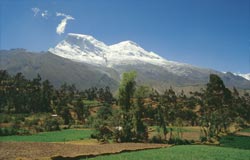
Bosque Unchog: Thanks to expeditions by the Louisiana State University, this site attained ornithological fame when 4 new species to science were discovered here in the seventies. The most attractive of these is the stunning Golden-backed Mountain-Tanager. The others are not quite so fancy but both can be found on this isolated mountain. The Bay-vented Cotinga and the strange Pardusco are just two more of the special birds of Bosque Unchog. Obviously the remoteness of the area will dictate that we will have to camp, but this will be as comfortable as possible. Our field staff will prepare camp and food for us while we use our time to go birding. There is much else to see here.. the Rufous-browed Hemispingus and Coppery Metaltail are just two more Peruvian endemics that can be found a host of other species here: At the higehr elevations we will have a chance of seeing the suitably named Elfin Forest Tapaculo and at treeline the Line-fronted Canastero. In the taller forests on the mountain we may see the Rufous Antpitta that occurs on Unchog, probably a full species in its own right and definitely worth the effort that we will be making on one day at least. Ochraceous-breasted Flycatcher, Golden-collared Tanager, Buff-breasted and Chestnut-bellied Mountain-Tanagers can be seen and they will be nice additions to our potentially spectacular list of tanagers here. We shall have a very busy few days here with Swallow-tailed Nightjars near our camp, looking for Bay and Chestnut Antpittas, White-chinned Thistletail, Sword-billed Hummingbird, Mountain Velvetbreast and others before our descent into the valley where the endemic Brown-flanked Tanager can be found. Nights in Tented Camp. (B,L,D)

A last mornings birding at this mythical birding locality, and then return to Huanuco where we stay in our comfortable hotel. (B,L,D)
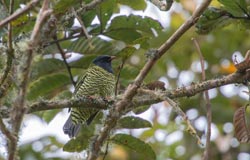
Today we will travel to Huaraz. Crossing the divide of the two mountain ranges that dominate this part of the tour - the Cordilleras Blanca and Huayhuash. In the afternoon we’ll do some late high altitude birding for Ground-tyrants, Gray-breasted and Rufous-bellied Seedsnipe. We should be at the comfortable Hotel Andino just after dark. Night Hotel Andino. (B,L,D)

Two full days birding the Andes of the Cordillera Blanca in the shadow of Peru’s highest peak, Huascaran. We will concentrate our birding efforts at Quebrada Llanganuco above the village of Yungay and the Polylepis groves here. It is not unusual to find Tit-like Dacnis where there are Gynoxis but it will be a bird endemic to Peru that will require some effort. The White-cheeked Cotinga is associated with mistletoe so we will locate its food-source as our best means of seeing this enigmatic bird. Other birds we may see here include Ancash Tapaculo and if we are really fortunate Koepcke's Screech-Owl can sometimes be found at a day-time roost. Other rare birds to look for include Ash-breasted Tit-Tyrant in the Polylepis whilst Plain-tailed Warbling-Finch (endemic), Rufous-eared Brush-Finch (endemic) and Maranon Tit-Tyrants should be encountered. We shall also make a special effort to find the endemic Pale-tailed Canastero (the cinnamon-tailed form occurs here), another endemic as well as more widespread Andean birds. Hummers like Rainbow Starfrontlet, Andean Hillstar and Blue-mantled Thornbil are possible and as in most habitats here in South America there is always a good selection of tyrant-flycatchers, Yellow-billed Tit-Tyrant and Jelski's Chat-Tyrant can be seen in the cover of forest patches and scrub but we’ll scan the open areas for those ground-tyrants as Spot-billed, Rufous-naped and White-browed Ground-Tyrants are here too. All nights in our comfortable hotel in Huaraz. (B,L,D)
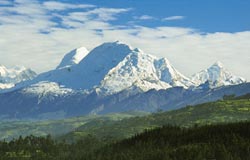
Today we’ll drive to Lima but break our journey with some birding stops including Lago Conococha where Andean waterfowl will be our interest. We should see many Andean Geese, Andean Ibis as well as Giant Coots. On the way into Lima we’ll visit the Laguna Paraiso for shorebirds, terns including Peruvian tern and others. We’ll arrive in Lima in time for flights home. (B,L)
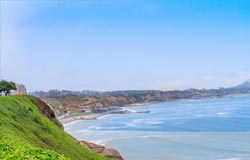
NOTE: The very nature of the isolated areas we will be visiting at Bosque Unchog and the Satipo road means we will have to camp for four nights. Our camp crew will take care of everything. However, everyone must bring a good sleeping bag for the nights in camp. The camps are as comfortable as possible with dining tents and folding tables and chairs, plus individual sleeping tents with comfortable sleeping matrasses’s Portable warm showers and a latrine tent will be available. Horses will carry our gear to camp and be available, if needed, for riding on up-hills back to camp after a long days birding.
2019 Prices per person in US$:
Prices are available upon request.